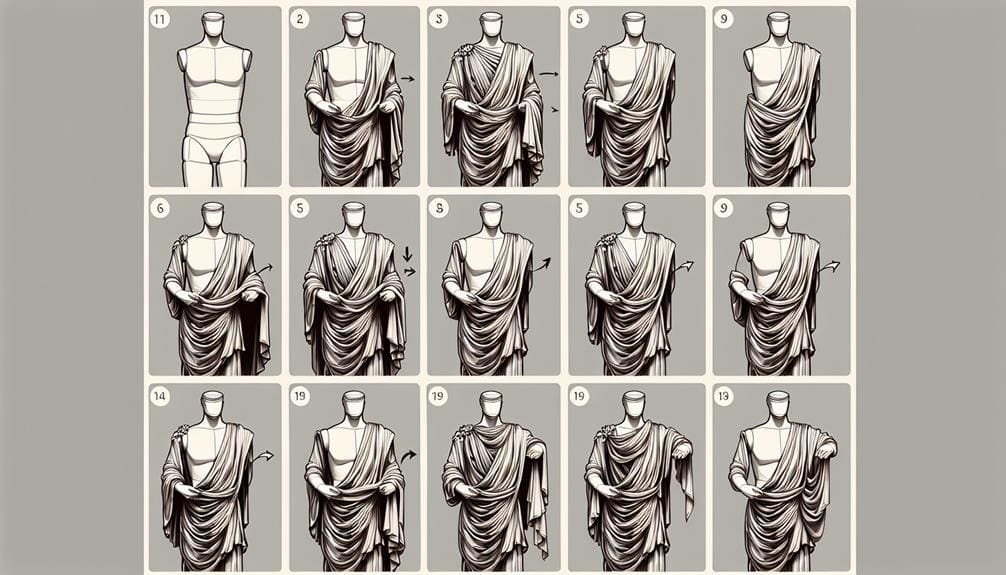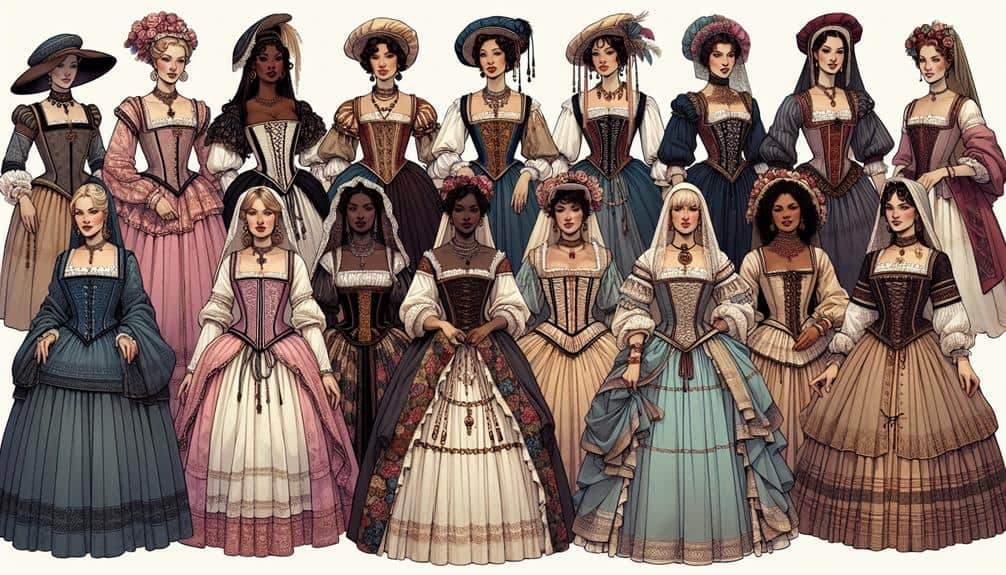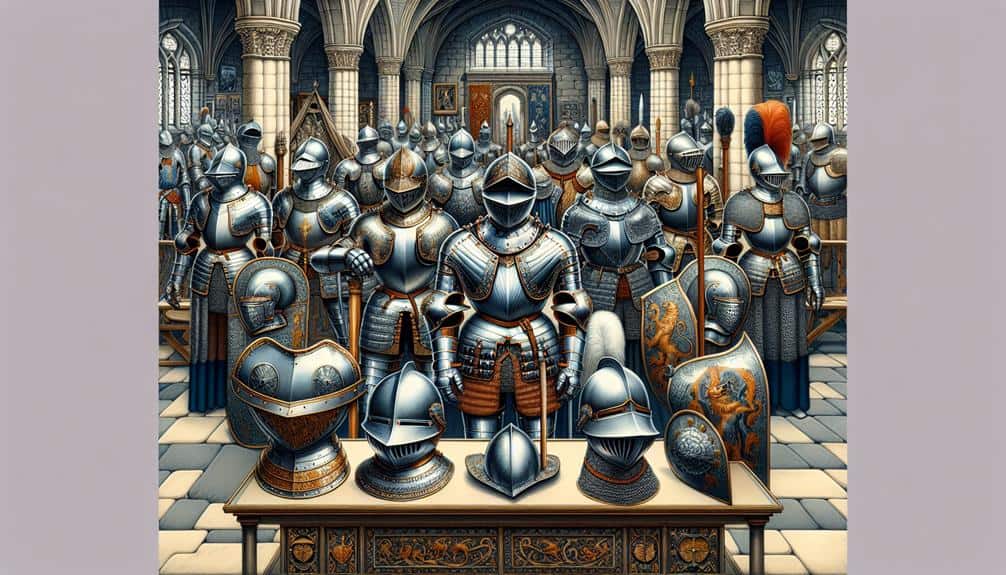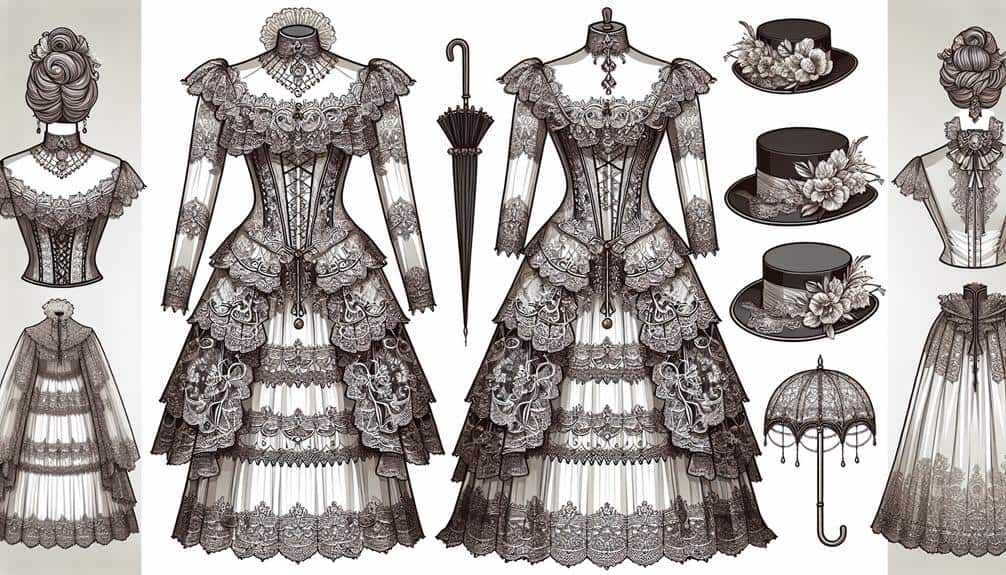Imagine the elegance of the Roman Senate, where power and prestige were draped in the folds of a toga. Just like a senator's toga conveyed authority, your draping technique can set the tone for your ancient Roman ensemble.
But did you know that the way you drape your toga can reveal your social status and political affiliations? Understanding this subtle art can elevate your costume game to a whole new level.
Stay tuned as we unravel the secrets behind achieving that perfect Roman senator look through the art of toga draping.
Key Takeaways
- Choose linen or cotton fabric for authenticity and graceful draping.
- Master the traditional Roman toga draping technique for an accurate senatorial look.
- Opt for white or natural tones and consider adding a stola for authenticity.
- Complete the attire with laurel wreath, bulla, Roman sandals, and a stylish belt.
Materials Needed for Toga Draping
To drape an ancient Roman senator toga accurately, you'll need three yards of white fabric, preferably linen or cotton, to achieve the traditional look. Choosing the right material is important to capture the essence of the Roman attire. Linen and cotton fabrics were commonly used during ancient Roman times due to their breathability and draping capabilities. These fabrics will allow the toga to flow gracefully around your body, replicating the elegant drape of a senator's garment.
In addition to the fabric, you'll require basic sewing techniques to hem the edges of the toga for a polished finish. Hemming ensures that the fabric edges are neatly sealed, preventing fraying and giving the toga a clean look. Simple hand-stitching or the use of a sewing machine can be employed for this purpose. By mastering these techniques and selecting the appropriate materials, you can create an authentic ancient Roman senator toga that embodies the grandeur of the past.
Step-by-Step Toga Draping Instructions
To master the art of draping an ancient Roman senator toga with authenticity and precision, meticulous attention to detail is important as you start on the step-by-step journey of recreating this iconic garment. Historical accuracy is key when selecting the fabric for your toga. Opt for linen or wool, as these were commonly used in ancient Rome. Linen offers a light, breathable option, while wool provides a more luxurious feel.
When it comes to toga styling, follow the ancient fashion trends closely. Begin by draping the fabric over your left shoulder, leaving the right arm free. Pull the fabric snugly across your chest and drape it over your left shoulder again. Secure the toga with a brooch or pin at the right shoulder. Adjust the length to fall elegantly to your ankles.
Tips for Authentic Roman Senator Look
For an authentic Roman senator look, attention to detail in garment selection and draping technique is pivotal to embodying the historical essence of this iconic attire. Roman fashion was characterized by its elegance and simplicity, with garments made of fine fabrics like wool and linen. To achieve historical accuracy, opt for a toga in white or natural tones, as these were commonly worn by Roman senators to signify their status. Additionally, consider accessorizing with a stola, a long tunic worn underneath the toga, to add layers and authenticity to your ensemble.
When draping your toga, make sure it's folded and arranged in the traditional Roman style. The draping should be done in a way that reflects the dignity and formality associated with Roman senators. Pay attention to the length and flow of the fabric, as this can greatly impact the overall look. By focusing on these details of Roman fashion and historical accuracy, you can truly embody the essence of a Roman senator in your attire.
Common Mistakes to Avoid
When draping your toga for an authentic Roman senator look, be mindful of common mistakes that can detract from the historical accuracy and overall essence of the attire. To guarantee a polished appearance, avoid wrinkles in your toga fabric. Wrinkles not only diminish the grandeur of the garment but also suggest a lack of attention to detail. Proper draping techniques are essential in achieving an elegant and dignified Roman senator look.
One common mistake to avoid is uneven draping. Make sure the fabric is evenly distributed around your body to create a balanced and symmetrical appearance. Additionally, be cautious of excess fabric bunched up around the waist or shoulders, as this can disrupt the clean lines of the toga.
Another pitfall to steer clear of is overly tight or loose draping. The toga should fit comfortably and gracefully drape over your body without being too restrictive or billowy. By mastering the art of toga draping and paying attention to these common mistakes, you can confidently embody the distinguished presence of an ancient Roman senator.
Accessories to Complete the Toga Attire
Enhance your Toga attire with carefully selected accessories that complement the distinguished Roman senator look. For historical accuracy, consider adding items such as a laurel wreath, which symbolizes victory and honor, and was often worn by Roman elites. You can also include a bulla, a protective amulet worn by children of high status, to add an authentic touch to your ensemble.
In modern adaptations of Toga attire, you may opt for items like leather sandals or Roman-style shoes to match the traditional look while ensuring comfort and practicality. To add a contemporary twist, consider incorporating a stylish belt or sash around your waist, which not only helps secure the toga but also adds a touch of sophistication to your outfit.
Remember that accessories play an important role in completing the overall look of your Toga attire. By carefully selecting pieces that blend historical accuracy with modern adaptations, you can embody the essence of a Roman senator with style and flair.
Frequently Asked Questions
How Long Did It Typically Take for an Ancient Roman Senator to Drape Their Toga?
Typically, an ancient Roman senator would spend around 15 to 20 minutes draping their toga. Mastering toga draping techniques was essential for senators due to the garment's symbolism, fashion trends, and significance in senatorial attire in ancient Rome.
Were There Specific Rules or Guidelines for the Color of a Senator's Toga?
In ancient Rome, there were strict rules on toga color symbolism. Senators usually wore a pure white toga with a purple stripe to signify their status. Toga fashion trends could slightly affect fabric choices, but etiquette was paramount.
What Were the Consequences for a Senator if Their Toga Was Not Draped Correctly?
Incorrectly draping a senator's toga symbolized disrespect for tradition and authority. Punishments for toga etiquette breaches ranged from fines to public shaming, damaging a senator's reputation and political standing. Following senatorial decorum was essential.
Did Ancient Roman Senators Wear Any Undergarments Beneath Their Togas?
When it comes to toga fashion, wearing undergarments was taboo for stylish senators. Toga etiquette dictated that going commando was the norm. So, ancient Roman senators dared to drape their togas without any hidden layers beneath.
Were There Any Specific Rituals or Prayers Associated With the Process of Donning a Toga for a Senator?
When donning a toga, ancient Roman senators partook in elaborate rituals and ceremonies. These practices symbolized their status and connection to the gods. The toga was not just attire but a representation of their authority and piety.



